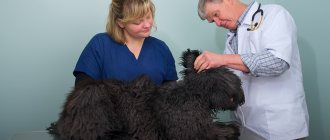The article was finalized and certified
Dubovitsky Yuri Igorevich
Veterinarian
Ask a Question
Every owner has at least once seen his dog trembling on the street or at home. Sometimes trembling occurs for completely natural reasons, for example, if the animal is simply frozen, but in some situations it is one of the alarming signs of a serious illness. In this article we will try to find out why the dog is trembling and how you can help your pet friend.
Tremor as a sign of disease
Trembling in dogs
- rapid rhythmic muscle contractions of individual parts of the body (for example, limbs) or the whole body, which the animal cannot control. Scientifically, trembling is called tremor. Tremor cannot be called an independent disease; rather, it is a symptom of some disease. Tremors most often occur in the following cases:
Electrolyte imbalance.
The dog tucks its tail and trembles as if it were frozen. This happens with electrolyte imbalance, when the ratio of magnesium and potassium in the body is disturbed. The causes of this condition are often poor nutrition, as well as problems with the thyroid gland and kidneys. If there are problems with electrolyte metabolism in dogs, in addition to tremors, the following symptoms are observed: convulsions, a drop in blood pressure, pale mucous membranes, coldness of the extremities, irregular pulses, possible vomiting and a rise in temperature. In the clinic, a dog with this problem is given intravenous water-salt solutions;
Poisoning.
When a dog does not eat and is trembling, it can be assumed that it has been poisoned. Moreover, poisoning can be either food poisoning (eating expired foods, ingesting fertilizers, etc.) or non-food poisoning (snake bite, inhaling methane, etc.). Common signs of poisoning in addition to tremors include: seizures and problems with coordination, excessive salivation, noisy breathing, increased blood pressure (more than 150/100), decreased or increased temperature (less than 37 degrees), foaming at the nose or mouth, blueness or redness of mucous membranes, vomiting and diarrhea (with or without blood), dilated pupils. First aid can be provided to your dog at home if you are sure that the cause of the poisoning is eating stale food. The owner should provide a flow of fresh air into the room where the dog is, and then induce vomiting and then give an absorbent (activated carbon, Phosphalugel, etc.). If the cause of poisoning is not clear, you need to urgently take your pet to a veterinary hospital;
Epilepsy attack.
The animal trembles and sticks out its tongue during an attack of epilepsy - a serious disease of the nervous system, which is characterized by severe convulsions. The disease most often occurs in German shepherds, dachshunds, boxers, St. Bernards and cocker spaniels. The disease can be triggered by traumatic brain injuries, electric shocks, infections, cancer and severe poisoning with heavy metals and poisons. In addition to trembling, the main signs of epilepsy in dogs include: restless behavior, active salivation, heavy noisy breathing, whole body convulsions, vomiting, loss of consciousness. Usually the attack goes away 5-7 minutes after the start, the owner at this time needs to open the windows, lay the pet on its side, the clenched teeth can be loosened with a tablespoon so that the animal does not bite its tongue. Immediately after an attack, you need to dial the doctor’s number and make an appointment. The specialist will prescribe anticonvulsants and antiepileptic drugs;
Allergic reaction.
The dog is shaking, as if chilled, and is panting heavily due to an allergic reaction to some component of the new food or to a medication. Also, in such a situation, the animal may drool and snot profusely, and may have upset stool. The situation can be corrected by taking antihistamines (Suprastin, Desloratadine, etc.);
Hypothyroidism.
The dog is trembling and lethargic with hypothyroidism - a lack of thyroid hormones that occurs against the background of immune diseases, cancer, obesity, infectious and parasitic diseases. The following symptoms are also found in dogs with this disease: rapid weight gain, increased heart rate, bowel problems (diarrhea, constipation), dry skin and active hair loss, refusal to play and communicate with the owner. The following dog breeds suffer from hypothyroidism more often than others: golden retrievers, Irish setters, dachshunds, cocker spaniels, and Dobermans. Hypothyroidism is treated with the use of drugs that replenish the deficiency of thyroid hormones, which are prescribed by a veterinarian;
An attack of hypoglycemia.
If a dog's hind legs or front legs are trembling at the same time, the culprit may be an attack of hypoglycemia during diabetes mellitus, when the level of glucose in the blood is critically low. The main causes of this condition are considered to be problems with the liver and endocrine system, stress, and prolonged fasting. In addition to tremors, symptoms of hypoglycemia include: lethargy, loss of appetite, diarrhea, severe drooling, and in severe cases - convulsions, paralysis of the limbs, loss of consciousness. If the dog owner is absolutely sure that this is a hypoglycemic state, you can quickly give the dog something sweet to drink (water with sugar or honey). After such manipulations, you should contact your doctor;
Viral or parasitic infection.
Very often, a dog will not eat and tremble if it has contracted a viral or parasitic infection. There are many illnesses that cause tremors: adenovirus, parvovirus enteritis, viral hepatitis, plague, toxoplasmosis, piroplasmosis and other diseases. Rise in temperature, stool disorders, cough, vomiting are just some of the signs of the diseases mentioned. Both viral and parasitic infections are treated only with those prescribed by the doctor after diagnosis;
Worms.
The dog often trembles even with worms. In addition to tremor, symptoms of helminthiasis include problems with digestion and stool, weight loss, bad breath, gas formation, and an increase in abdominal volume. To combat parasites, the animal needs to take deworming medications (Drontal, Milbemax, Advocate, etc.);
Stress.
It also happens that a pet whines and trembles under stress, caused, for example, by a change of place of residence. In case of a nervous disorder, the dog can be both excited and apathetic, possibly non-standard behavior (eating feces, howling, disobedience, running in circles, etc.), plaintive whining, refusal to eat, or an excessive appetite. Experienced dog breeders believe that the best cure for stress is exercise with the owner (long walks together, learning new commands, preparing for competitions, etc.). Sedatives (Cat Bayun, Antistress, Stop-stress, Sanal Relax, etc.) can have a good healing effect, but before taking these medications you should consult a veterinarian.
Diagnostics
If the condition is accompanied by life-threatening symptoms - for example, epistatus, respiratory failure, the dog must first be stabilized. Next, diagnostics are carried out.
The veterinarian examines the dog and rules out the most common pathologies that cause trembling. These are abdominal pain, fever, hypoglycemia, hypokalemia, kidney disease, leptospirosis, viral infections. This may require a number of tests - a general clinical blood test, a general biochemical analysis (which evaluates the functioning of the kidneys, liver, and measures glucose and potassium in the blood). A blood test is also taken for leptospirosis, plague, and feces for parvovirus enteritis.
With the help of ultrasound diagnostics and x-rays, tumors of the intestine and internal organs, foreign bodies in the gastrointestinal tract, gastric volvulus, intussusception, cystitis, prostatitis, endometritis, pyometra, colitis, enteritis - everything that can cause abdominal pain are excluded.
In some cases, an X-ray of the spine is recommended to rule out compression fractures, injuries to the limbs and chest.
To exclude tumors or diseases of the spinal disc, a myelogram can be performed - this is an X-ray examination of the spine with a special dye.
A CT (computed tomography) scan or MRI (magnetic resonance imaging) scan can help detect structural changes in the brain or spine.
To exclude encephalitis, a study of cerebrospinal fluid (cerebrospinal fluid) is used.
Electromyography (EMG) can help diagnose neuromuscular disorders.
What to do if your dog is shaking
Is it necessary to see a doctor? First you need to observe your pet: is the trembling accompanied by any other alarming symptoms? If the animal’s temperature has risen, the appetite has disappeared, there are disturbances in the gastrointestinal tract, the color of the mucous membranes has changed, the pressure has jumped or dropped, the pulse is not normal, then it’s time to dial the veterinarian’s number. Most of the ailments we have listed (infectious and heart diseases, endocrine abnormalities) require urgent medical intervention. So if the animal is clearly unwell, the owner’s best solution may be to go to the veterinary clinic.
Poisoning
Many household items are toxic to puppies. Raisins and grapes, bleach, insecticides, rat poison, prescription antidepressants and antifreeze. Some toxins cause tremors and shaking in puppies when ingested. In addition, puppies may vomit, have severe diarrhea, and appear visibly upset and uncoordinated. Your puppy's heart rate may increase. In extreme cases, your puppy will have seizures.
If you suspect your puppy has ingested a toxic substance, you need to act quickly. First, don't let your puppy eat more of the toxin. You will need to call your veterinarian right away to make an appointment. If possible, pack up the poison wrapper and take your puppy to the vet. Even if the substance is illegal or questionable, be honest with your veterinarian. Your veterinarian is here to help your dog, and your honesty could save his life.
When a dog's trembling is not dangerous
Fortunately for every owner, tremors in dogs also occur for completely harmless reasons:
- It happens that a dog’s paws, and sometimes his whole body, tremble in the cold.
The animal curls its tail, cowers, and breathes intermittently. Moreover, a pet can tremble not only on a chilly street, but also at home, for example, after bathing, if the room is cool; - Males almost always tremble when they see a female in heat.
At the same time, they can behave extremely restlessly (attempting to break off the leash, run away, etc.), bark and whine, breathe loudly; - Many dogs tremble from an excess of feelings
, for example, when they see their owner returning home after a long absence. This behavior is most often found in small pocket dogs (like the Toy Terrier), as well as large dogs with docked tails. By the way, older dogs often have jaw trembling during emotional experiences; - Sometimes the dog will tremble and pant when experiencing fear
(for example, when hearing ambulance sirens or fireworks); - There is no need to be afraid if the animal trembles in its sleep
(but when it wakes up, the tremor goes away during wakefulness). Most likely, he is dreaming about something exciting.
Hypomyelination
Hypomyelination is more commonly known as shaken puppy syndrome (SPS). SPS is an inherited defect that causes delayed myelination of nerves. Myelin is a substance that covers nerve cells. This is important for fine muscle control. At birth, puppies with SPS appear normal. The disease usually appears when puppies are one to two weeks old. Puppies with SPS exhibit tremors, especially in the hind legs. In more severe cases, affected puppies have difficulty feeding due to tremors.
Diagnosis involves ruling out all possible explanations. This may include CT scan, electromyography, MRI or myelography. The only way to truly confirm SPS is by microscopic examination of the puppy's spinal cord after death, if it occurs. There is no specific treatment for SPS. Fortunately, most puppies with SPS eventually recover by the age of one year. In milder cases, puppies may recover by three to four months of age. Despite recovery, most puppies with SPS will have mild tremors in their hind legs for the rest of their lives.
Emergency care and treatment
For epilepsy, special drugs are used. The earlier the course of treatment begins, the better the effectiveness of therapy. But to use phenobarbital, there must be indications (clinical picture in the dog):
- more than one seizure attack in 2 months;
- attack within 1-2 weeks from the moment of head injury;
- prolonged shaking in dogs;
- difficult periods between attacks;
- detection of structural violations.
Treatment of seizures should be carried out as quickly as possible. It is necessary to choose the right drugs against epileptic seizures. Non-sedating products should not be used for dogs, as they have a hepatotoxic effect. But other means also have a number of negative effects.
The inexpensive drug phenobarbital is well suited at an early stage of the disease. Potassium bromide has a similar effect. But this substance accumulates slowly in the brain - the therapeutic dose is reached over several months, so relapses of seizures are possible at the onset of the disease.
If brain inflammation is caused by non-infectious causes, then glucocorticoids are used. In most dogs, improvement in condition with moderate levels of encephalitis is observed within 3-5 days from the start of treatment. Infectious encephalitis precludes the use of this type of anti-inflammatory drugs. Treatment course:
- prednisolone at a dosage of 1 mg/kg once a day for 7-10 days;
- if clinical signs improve, the dose is reduced to 0.5 mg/kg;
- subsequently, the dosage is gradually reduced as symptoms improve;
- in case of relapse (sharp dose reduction), a return to the initial course is necessary;
- treatment is continued until the clinic disappears - 4-6 weeks;
- Lifelong use of low dosage glucocorticoids is possible for some highly sensitive dogs.
Muscle shaking in a dog, associated with secondary brain diseases and reactive causes, is a pathological symptom. To remove and eliminate it, it is necessary to treat the main etiological factor. In this case, special drugs against epilepsy are not required. Thus, in case of liver failure, it is necessary to maintain liver function, and in case of vascular lesions of the brain, inflammatory edema is relieved and the heart function returns to normal.
There is no universal reflex for treating seizures in dogs. In case of brain damage, constant monitoring of therapy and its correction is required. The concentration of drugs in the blood serum is monitored:
- selection of individual treatment;
- determination of toxic effect;
- determination of therapeutic concentration.
Treatment is changed if therapy does not produce the desired results. The first stage is to increase the concentration of the active substance, but this leads to increased toxicity. Then it is necessary to change the medicine or supplement it. A common combination is a mixture of potassium bromide and phenobarbital.
When your dog needs emergency help:
- the duration of the seizure attack is more than 5 minutes;
- status epilepticus – shaking in the dog is followed by loss of consciousness for 30 minutes;
- at least 3 attacks in three hours.
In an emergency situation, it is necessary to maintain the normal functioning of the animal’s body and stop the attack. To prevent the dog's muscles from shaking, diazepam and a loading dose of phenobarbital are prescribed. Then the drugs are administered in a minimal dosage.
The use of various antispasmodic drugs is effective. The dog is injected intravenously with a 25% solution of magnesium sulfate every 10-12 hours, 5-10 ml. Treatment with diazepam and elenium lasts for two months.
The effectiveness of intravenous injection of glucose solution is noted (40%). It is also recommended for animals to be prescribed antiallergic drugs - diphenhydramine, suprastin, prednisolone. Be sure to use complex vitamin and mineral products. If symptoms of dehydration are severe, fluid therapy should be administered.
Happiness/Excitement
Most puppies tremble when they feel happy or excited. This is because strong emotions trigger the release of adrenaline in the body. Adrenaline triggers the animal's fight or flight response. This helps the body react faster. The heart beats faster, blood flow to the brain increases, and the ability to feel pain even decreases. Your dog may experience this reaction when he is happy to see you or is expecting a walk. This reaction is most often seen in younger dogs with less impulse control.
Your puppy's extreme nervousness upon arriving home may reflect an anxiety disorder. If your puppy is destructive when you leave, can't stand being away from you, and reacts strongly when you come home, he may be struggling with separation anxiety. Some cases of canine anxiety can be treated with training.
In mild cases, counterconditioning can help your puppy associate a negative situation with something positive. This may include offering expensive foods and toys that are only given out when you leave. Moderate to severe cases require a more complex training program. This involves getting your puppy used to being alone through many short separations, gradually increasing the duration over many weeks. Desensitization is a long and complex process.











